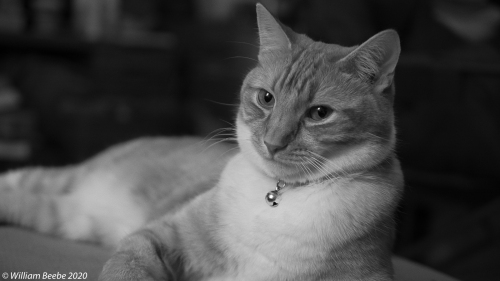
In the last post, Marc Beebe (https://marcbeebe.wordpress.com) asked:
Tell us the secret of how you get your cat to look normal: mine always pose goofy, even when they aren’t posing.
To be honest, there are no hard and fast rules to photographing cats to produce “normal” photos. Normal is always going to be in the eye of the beholder. I can’t offer any hard-and-fast rules, but what I am about to offer are, to quote Hector Barbossa in “Pirates”, “what you’d call ‘guidelines’ than actual rules.”
First get yourself a camera that feels comfortable to use. It doesn’t have to be fool frame, or micro four thirds, or APS-C, or any given sensor size or brand. I use Olympus because that’s what I like to work with. If you’ve got a piece of hardware you’re afraid to really use and get to know, then you’ll never get the best out of the hardware, you, or the subject. I have several cameras scattered about, but when it comes to little creature candids I reach for the Olympus Pen F with a prime on the front, either the 17mm or the 25mm. That’s a picture of the setup at the start taken with the Panasonic Lumix G9 and Lumix 30mm macro using the G9’s built-in Monochrome.D.
A comfortable camera is a camera you easily learn all about. You learn how its various modes work, and you learn a bit of about its many buried features. For the Pen F I learned to put the camera into silent mode so that it makes no sound when the shutter it tripped. The only part that makes any sound is the PL 25mm when it’s focusing, and then it’s rather quiet. The other feature I’ve enabled is touch-to-focus-and-expose on the LCD. That way I can frame with the rear LCD and then touch right where I want focus to take place during the exposure. The Pen F is for my purposes fast and silent, which sounds like it shouldn’t matter for resting cats, but you’d be surprised. Their faces are always active, and then there’s those moments where they aren’t lying about.
As for the animal subjects, keep the camera around so they get used to seeing it. Then start using it so they get to seeing you with it. They’ll reach a point where they don’t care and are relaxed when you pick up the camera. With everything set to silent, no sudden moves, and familiarity with you using the camera, the little guys will begin to just hang about while you take photos. Know that you’re going to get a lot of bad photos, and if you’re honest, when you go back to chimp, you’re going to curate and delete a lot of them before you pull any of them off the camera. Once off the camera and in some sort of post process, you’re going to curate and remove even more.
I’m sure there’s more to recommend, but the key things to emphasize are silence, lots of practice, steady familiarity, and patience on your part.



You must be logged in to post a comment.